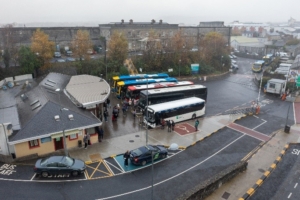The Connecting Ireland Rural Mobility Plan is a major public transport initiative developed by the National Transport Authority (NTA) with the aim of increasing connectivity, particularly for people living outside our major towns and cities. The plan aims to improve mobility in rural areas by providing frequent and affordable transport services that offer freedom to travel and sustainable transport connections.
 The Connecting Ireland Rural Mobility Plan continues to make public transport more accessible for people in towns and villages across the country in a number of ways by:
The Connecting Ireland Rural Mobility Plan continues to make public transport more accessible for people in towns and villages across the country in a number of ways by:
- Adding new high-frequency services;
- Enhancing existing services; and
- Providing improved connectivity to the wider transport network
The NTA continues to review where improvements are required with a view to introducing new and enhanced connections between villages and towns; and providing better access to public transport in rural areas.
These improvements are creating a more effective and integrated system, which brings people in rural areas to where they want to go, when they want to get there.
What Key Issues Does Connecting Ireland Address?
As part of the Connecting Ireland Plan, the NTA completed a comprehensive assessment of the existing network of regular public transport services operating across the country on a county-by-county basis. This has given us a clear understanding of how well the public transport network currently serves our towns and villages in terms of service levels at certain times of the day and days of the week. It has also helped us to clearly identify the issues such as gaps in the network where the option to use public transport is not available.
The transport sector is one of the largest contributors to Ireland’s carbon emissions. Our reliance on the car to get around is the key reason for this. 7 out of every 10 trips undertaken in Ireland is by car, to make matters worse, half of short trips under 2km in length are made by car. By improving the transport network outside cities and towns, Connecting Ireland is providing people with a viable alternative to the private car.
How Are These Key Issues Being Addressed?
Outside the major urban centres, Ireland’s settlement pattern is distributed in a highly dispersed manner. Therefore, it is difficult to cost-effectively organise public transport services to cater to everyone’s needs. In very isolated rural areas, the demand for travel may be so low as to preclude the provision of traditional bus services. These needs may be more readily met by innovative means, such as demand responsive services, local hackney services or community car schemes.
The Connecting Ireland bus service improvements will be led by NTA in partnership with TFI Local Link, Bus Éireann and other and bus operators However, local authorities also play a key role by authorising new bus stopping places, providing roadside turning and regulatory facilities, improving access to rail and interurban station forecourts, prioritising access by bus to town and village centres and working with us to promote and market the use of public transport.
Service enhancements proposed under Connecting Ireland Rural Mobility Plan aim to improve connections by adding weekend, evening and mid-day services and better co-ordination with existing services.
A collaborative, partnership approach to public transport network planning is a principle underpinning Connecting Ireland. The extensive engagement undertaken to inform the plan has generated valuable discourse and demonstrated the value of a collaborative approach.
Benefits of Connecting Ireland
The enhanced network will greatly improve interconnectivity between communities.
We estimate the implementation of service improvements emerging from Connecting Ireland work will provide:
- Over 70% of those living outside the Cities will have access to a public transport service that provides at least three return trips each weekday to a nearby town
- Improved mobility options for those in remote areas with the provision of Demand Responsive and other innovative transport services
- Over 100 new Local Centre connections from rural settlements in the hinterland
- Over 100 new County Town connections from all types of settlements around County Towns; and
- Over 60 new Regional Centre/City connections, from all types of settlements around these Centres/Cities.
